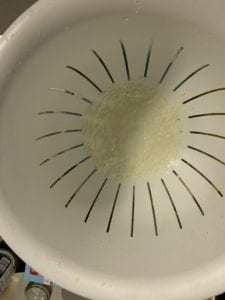Hypothesis: How does the amount of vinegar and type of milk affect milk casein produced?
For this second experiment, I did some further research and found a couple of different suggestions and tips from people online:
- Soaking the milk curd in vinegar will make the curd smoother, less crumbly and easier to mould
- Using more vinegar will create more milk curd
- Other types of milk such as buffalo, sheep and yak have more/less casein than regular cow milk
From this new information, I wanted to experiment and try it out to see how much truth there was to these tips. Hence, I modified my original methodology with 3 different experiments:
- After separating the curd, dump it in again in vinegar for 1 hour before moulding
- Doubling the amount of vinegar added (12 tablespoons to 500ml of milk)
- Use yak milk
Results:
For the first round, I used much more vinegar than I did for the first experiment. Expecting larger chunks of curd to form, I instead saw the mixture to be very powdery and less chunky. This was confirmed as I placed the milk through the strainer. Most of the milk past threw and I only attained a small amount of curd. This was surprising as I used double the milk from the first experiment but was only able to attain approximately the same or even less curd.

For the second round, I followed a similar original methodology, but just added the curd into a bowl of vinegar to soak. At the 30 minute mark, I checked on it and saw the curd has become very powdery once more and became smaller. By the time the hour was up, half of the curd has become small powder and I was left with a very small amount of curd that wasn’t even that easy to mould, just very sticky and wet.

In the last round, I managed to find 200 ml yak milk on Hema. I followed the original methodology and attained the same amount of milk curd as when I used 500 ml of cow’s milk which I was extremely impressed with. It also seemed much easier to mould and less crumbly.


Amount of curd left just from 200ml of yak milk

- Cow milk (500ml)
- Yak milk (200ml)
- Cow milk soaked in vinegar for 1 hour
Results:


cow milk after 2 days
Although the 200ml yak milk produced approximately the same amount of milk casein as 500ml cow milk, I found that even after 2 days of drying, the casein produced was much oilier than the cow milk. This may be due to the higher percentage of fat in the yak milk. Furthermore, as it was oilier, I found there were more cracks and would be easier to break than the cow milk which fully dried.



yak milk after 2 days
I learned that some of the myths found online may not be exactly true or I did it wrong as I found that soaking the milk casein in vinegar for the extra hour did make the casein a bit smoother, but it also significantly reduces the size of the casein clumps as it dissolved even further in the vinegar.

Moving forward, I decided to stick with cow milk. However in order for me to make a cup holder, I’d have to use a considerable amount of milk and perhaps make a mold.
Leave a Reply